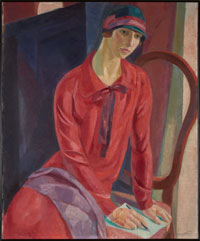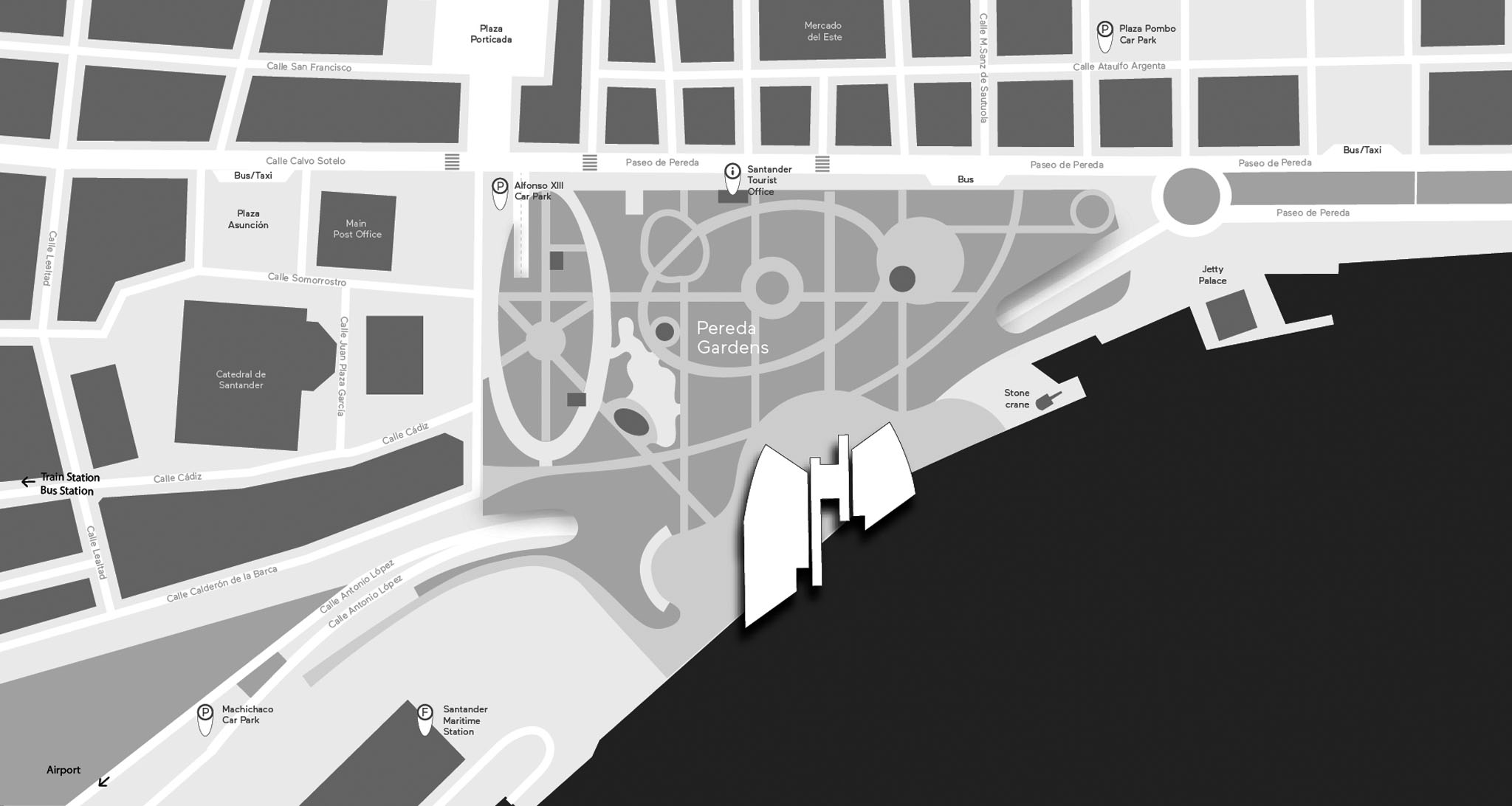Daniel Vázquez Díaz woman in red

Mujer de rojo, 1931.
Tempera on canvas. 106 x 89 cm
A MODERN WOMAN
Initially there is no information that helps us name the splendid sitter in this painting, Woman in Red, which Daniel Vázquez Díaz painted in 1931 and which has at times been referred to as Girl Dressed in Red. At one point, this painting was owned by the publisher, gallery owner and politician Agustín Rodríguez Sahagún.
Woman in Red is still a mystery, an enigma. It may not even be a portrait. Neither are Parisian in Flowered Hat or Dancer (both from 1906). Nor are the glittering Women of the Night (1907), strolling bawdily along the Grands Boulevards near a man holding a sign announcing a show at the Moulin Rouge; or La Négresse (1911); or Lady in Grey (1923), with her back turned towards us, reflected in a mirror.
We should recall what the painter said to Manuel Sánchez Camargo in 1962; under his alias ‘Pedro del Castillo’, he reported in the Pamplona newspaper Arriba España: ‘How often do we see in the street or the streetcar a head that makes us say: What a great portrait that man has! Or what a beautiful portrait of that woman we don’t know, whose colour, eyes and style impress us!’
Woman in Red plants the spectator before the quintessence of a modern woman from the Roaring Twenties, almost a Paul Morand heroine, with her vermillion dress, her bow, her cloche hat covering part of her forehead and her hair pulled back à la garçonne; the frame in which she is situated, the oval-shaped chair where she is seated, the geometric interior that is the hallmark of the scene…
The painting should be considered one of the artist’s most modern, as both its composition, with a strong geometric base, and its colours (similar to the ones we find in a luminous 1951 painting of Don Francisco in the Red Armchair, in which the robe worn by the lawyer Francisco Enríquez and the book he is holding in his left hand are the same colour) come from the zone of his oeuvre which most clearly reveals the benign influence of Robert Delaunay’s orphism.
If we look at the work of Vázquez Díaz (born in Nerva) from the perspective of the representation of a woman, in addition to enigmatic paintings like the ones listed above, the result affords a variety of realisations. Many of them reveal the link with a symbolist and ’98-style vein. Others are clearly Cézanne-style bathers. All of this has nothing to do with Woman in Red and a lot with Sorolla, Zuloaga and Romero de Torres. One mysterious portrait is the one of Gloria Laguna, an aristocrat and writer, the cousin of Antonio Hoyos y Vinent, and like him, always surrounded by scandal. In comparison, later we have the sophistication of the portraits of actresses like Sarah Bernhardt and Réjane, or of the opera mezzosoprano Lucy Arbell. And even later he painted the portrait of the Russian ballerina, Anna Pavlova, the Polish harpsichordist Wanda Landowska and the Ukrainian-Argentinian poetry reciter Berta Singerman. The portraits throughout his life of his wife, the Danish sculptor Eva Aggerholm, whom he met in Paris in 1908 and married three years later in Copenhagen, are endearing. He held an exhibit with her at the Modern Art Museum in 1921, with a catalogue with a prologue written by Juan Ramón Jiménez, a circumstance in which they were the honourees of a banquet organised by Ultra. Nor should we forget an enigmatic compatriot of Eva’s featured in a beautiful painting from 1919, Anna Lisa or Young Danish Woman with a Fishbowl.
Along with the Ultra circle, Vázquez Díaz and his wife interacted with both Robert and Sonia Delaunay, née Terk, a Russian, Cansinos’ ‘Sofinka Modernuska’ in El Movimiento VP. He had met them in Fuenterrabía during the ill-fated summer of 1914. Both the young Danish woman, with her red, blue and green striped shirt, and our Woman in Red have a something of the characters dressed by Sonia. The couple also often saw two Polish women, Wanda Pankiewicz, a textile artist and the wife of the painter Józef Pankiewicz (they were neighbours and friends of the Delaunays in Madrid, and their example was decisive in the Polish artist’s evolution), and Lucia Auerbach, who was married to Wladyslaw Jahl, one of the leading graphic contributors to Ultra, whom she helped in the ‘Ultraist decorative workshop’ they had on Calle Goya. Lucia Auerbach earned inclusion in Juan Ramón Jiménez’s Españoles de tres mundos; she ended up having a tragic fate, dying in Auschwitz. The other Ultraist women who stood out included Norah Borges, who appeared in the pages of Hélices (1923), the first and only poetry collection by Guillermo de Torre, the painter’s future husband, along with Vázquez Díaz; the Uruguayan pianist and composer Carmen Barradas, the painter’s sister; and Lucía Sánchez Saornil, who signed her verses as ‘Luciano de San Saor’.
Another woman who was more modern than that Madrid was the German Charlotte E. Pauly, who often relived in her memory her experience of being a student of Vázquez Díaz, the author of some paintings inspired by the Gypsies from Guadix and their caves, and a visitor to Morocco, which was Spanish at the time, and Portugal, whose route she probably learned from her master. A painter and writer, in the post-war years she lived in the GDR and illustrated a German edition of the poems of Federico García Lorca.
Another Vázquez Díaz disciple was a painter on whom—you’ll soon understand why—I shall dwell a bit more, the Madrid native Marisa Roësset, to whose ‘boyish fringe’ Manuel Abril alluded in his review for Revista de las Españas of her joint show with Gisela von Ephrussi held at the Museo Nacional de Arte Moderno in 1929. In 1924, she painted a self-portrait with hair à la garçonne and a bow, a painting that belongs to the Museo Reina Sofía. She appears the same year with the same hairstyle in another self-portrait in front of a vanity, wearing a loose outfit of some undefined colour, as we only know it from a period reproduction in sepia tones. In 1927, in the boldest and most avant-garde of her many paintings of this genre, this one painted from a subjective perspective, that is, reclining, and raising her eyes skyward, she is wearing—get ready—a bright red dress. Two years later, she depicted herself as a Mexican in a painting that is at Barcelona’s MNAC. In yet another self-portrait displayed in the 1929 show, she is once again wearing a bow at her neck. After listing the most important women in the painter’s milieu around that time, I have reached the conclusion that Marisa Roësset is the most likely candidate to be Woman in Red. It is not yet certain, just an intuition, or just a fantasy created with a certain veneer of likelihood. To be continued…
Juan Manuel Bonet, writer, art critic and expert on Vázquez Díaz.

